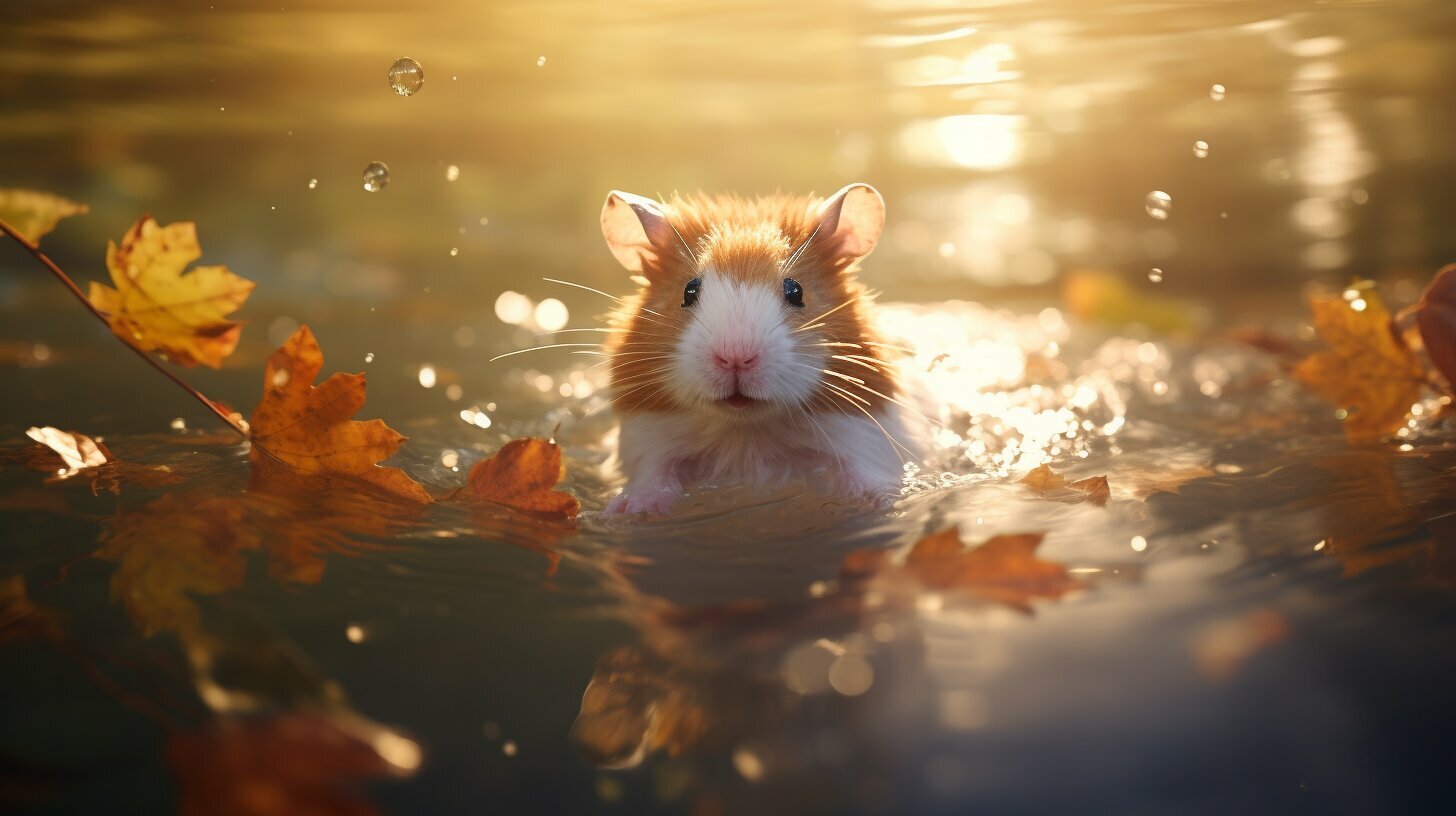Many people wonder if hamsters can swim in water due to their small size and adorable appearance. While hamsters are capable of swimming if they encounter water, it is not a natural behavior for them. In fact, hamsters are not well adapted for swimming and may struggle to stay afloat. It is important to understand their swimming ability and take precautions to ensure their safety.
Key Takeaways:
- Hamsters can swim if they encounter water, but it is not a natural behavior for them.
- They are not well adapted for swimming and may struggle to stay afloat.
- Hamsters prefer a dry environment and should not be put in water unless it is necessary for an emergency situation.
- Water can strip the oils from their coat, leading to dry and itchy skin.
- Putting hamsters in cold water can cause hypothermia and other illnesses.
Hamster Water Safety
While hamsters may have the ability to swim, it’s crucial to prioritize their safety when it comes to water. Hamsters are not natural swimmers and do not enjoy being in water. Placing them in water, whether it’s a bathtub or a pool, can be stressful and potentially dangerous for them.
Water can strip the natural oils from a hamster’s coat, making it harder for them to regulate their body temperature. This can lead to dry and itchy skin, causing discomfort for your furry friend. Additionally, immersing them in cold water can put them at risk of hypothermia and other illnesses.
Instead of bathing hamsters in water, it is recommended to provide them with a dry sand bath. This mimics their natural behavior of grooming themselves using sand or dust. You can set up a small area in their enclosure with chinchilla sand or bathing sand, which is readily available at pet stores. Hamsters will enjoy rolling around and cleaning themselves in the sand, keeping their coat healthy and free from excess oils.
| Hamster Water Safety Tips: |
|---|
| 1. Avoid placing hamsters in water unless it’s necessary for emergency situations. |
| 2. Provide a dry sand bath area in their enclosure for them to groom themselves. |
| 3. If your hamster gets dirty, gently wipe them clean with a damp cloth instead of submerging them in water. |
| 4. Keep their environment dry and ensure they have adequate bedding to maintain their comfort. |
By following these hamster water safety tips, you can ensure the well-being of your furry companion and help them thrive in their preferred dry environment.
Hamster Care Tips
To provide optimal care for your hamster, it’s important to understand their natural behaviors, including their approach to swimming. While hamsters are capable of swimming, they are not adapted for it and may struggle in water. It is crucial to keep their safety and well-being in mind when it comes to water-related activities.
One of the most important aspects of hamster care is maintaining a dry environment. Hamsters prefer a habitat that mimics their natural desert-like habitats in the wild. Putting them in water can strip the oils from their coat, making it harder for them to regulate their body temperature. This can lead to dry and itchy skin. Furthermore, immersing them in cold water can cause hypothermia and other illnesses.
Instead of bathing your hamster in water, it is recommended to provide them with a dry sand bath. Hamsters instinctively enjoy rolling around in sand, which helps to clean their fur and remove excess oils. You can set up a designated area in their enclosure filled with chinchilla sand or dust to mimic their natural behavior. This not only keeps them clean but also prevents any unnecessary stress or potential danger associated with swimming.
| Hamster Care Tips: |
|---|
| Keep the hamster’s environment dry |
| Provide a sand bath for cleaning |
| Avoid immersing hamsters in water |
| Use a damp cloth for gentle cleaning if necessary |
If your hamster does get dirty or has a soiled area on its fur, it’s best to clean them using a damp cloth. Gently wipe the affected area, being careful not to wet their entire body. Hamsters are known for their grooming habits and can clean themselves effectively, so frequent bathing is not necessary.
Understanding the swimming habits of hamsters and implementing the right care practices will ensure the well-being and happiness of your furry friend. Remember, providing a dry environment and avoiding unnecessary exposure to water are essential for their overall health.
The Dangers of Immersion in Water
Immersing hamsters in water can be detrimental to their health and well-being, leading to various risks and complications. While hamsters have the ability to swim, it is important to understand that they are not natural swimmers and are not adapted to spend a significant amount of time in water.
When hamsters are submerged in water, their fur becomes soaked and the natural oils present in their coat are stripped away. This can make it more difficult for them to regulate their body temperature, leading to potential issues such as hypothermia. Furthermore, prolonged exposure to water can cause their skin to become dry and itchy, which can be quite uncomfortable for these tiny creatures.
It is crucial to note that hamsters are prone to stress, and being exposed to water can be a source of significant stress for them. Placing them in a bathtub or a pool can be overwhelming and induce fear, which can exacerbate their stress levels. Additionally, attempting to force them to swim can result in accidents or injuries, further jeopardizing their well-being.
The Importance of Dry Sand Baths
Instead of subjecting hamsters to water baths, it is recommended to provide them with dry sand baths as a means of keeping their fur clean and healthy. Hamsters naturally enjoy burrowing in sand, and this behavior mimics their natural habitat. Setting up a designated area with chinchilla sand or children’s play sand can provide them with a safe and enjoyable means of grooming themselves. This not only prevents the risks associated with water immersion but also promotes their natural instincts and overall well-being.
| Risks of Immersion in Water for Hamsters: |
|---|
| Stripping of natural oils from fur |
| Difficulty in regulating body temperature |
| Dry and itchy skin |
| Potential hypothermia and other illnesses |
| Stress and fear-inducing |
| Risk of accidents or injuries |
In conclusion, hamsters should not be immersed in water unless it is absolutely necessary for emergency situations. Their natural habitat and preferences lean towards a dry environment, and subjecting them to water can lead to a range of health issues and stress. By providing alternatives such as dry sand baths, hamster owners can ensure the well-being of their beloved pets while keeping them clean and happy.
Bathing Your Hamster
Instead of bathing your hamster in water, there are safer and more suitable methods to keep them clean and comfortable. Hamsters are not naturally inclined to enjoy swimming, and water can actually be detrimental to their health if not handled properly. Water can strip their fur of essential oils, making it difficult for them to regulate their body temperature and leading to dry and itchy skin.
One alternative to traditional water baths is providing your hamster with a dry sand bath. Hamsters love to roll and dig in sand, and this can help keep their fur clean and free of dirt and oils. To set up a sand bath, simply provide a shallow container filled with chinchilla sand or children’s play sand. Your hamster will enjoy burrowing and rolling in the sand, which helps to naturally clean their fur.
If your hamster needs a more targeted cleaning, you can use a damp cloth to wipe them down. Wet the cloth with plain water or a small amount of hamster-safe shampoo, and gently wipe your hamster’s fur, avoiding their face and ears. It’s important to be gentle and avoid excessive rubbing, as this can cause stress and potentially harm your hamster.
Benefits of Dry Sand Baths:
| Benefits | Description |
|---|---|
| 1. Natural cleaning | Allows hamsters to clean their fur by themselves |
| 2. Safe and stress-free | Avoids the potential dangers and stress of water baths |
| 3. Maintains natural oils | Prevents stripping of essential oils from the fur |
| 4. Enrichment and activity | Provides a fun and engaging activity for hamsters |
By using these alternative methods, you can ensure that your hamster stays clean and comfortable without exposing them to the potential dangers of water baths. Remember to always prioritize your hamster’s well-being and provide them with a dry environment that suits their natural preferences.
Dry Sand Baths for Hamsters
Dry sand baths are a great alternative to water baths for hamsters, especially for dwarf hamsters who may struggle with swimming. Unlike water baths, dry sand baths provide a safe and enjoyable way for hamsters to groom themselves and keep their fur clean without the risk of water-related stress or injury. This method mimics their natural behavior of rolling in sand or dust to remove excess oils and keep their fur in pristine condition.
To create a dry sand bath for your hamster, you will need a shallow container filled with chinchilla sand or a specialized sand bath product available at pet stores. Avoid using regular sand or dusty substrates, as they can irritate your hamster’s respiratory system. Place the sand bath in your hamster’s enclosure, making sure it is easily accessible to them. You can also add tunnels or hideouts to enhance their sand bath experience.
When your hamster needs to groom themselves, they will instinctively enter the sand bath and start rolling around. This action helps to remove dirt, excess oils, and parasites from their fur. The sand particles help absorb oils and moisture, leaving their coat clean and fluffy. Additionally, the gentle abrasion of the sand on their skin can help prevent dry and itchy skin, promoting overall skin health.
| Benefits of Dry Sand Baths for Hamsters |
|---|
| 1. Mimics natural grooming behavior |
| 2. Helps remove dirt, excess oils, and parasites |
| 3. Prevents dry and itchy skin |
| 4. Promotes overall skin health |
Important Considerations
- Ensure the sand bath container is shallow enough for your hamster to easily enter and exit without difficulty.
- Regularly clean and replace the sand to maintain cleanliness and prevent bacterial buildup.
- Monitor your hamster during their sand bath sessions to ensure they are using it safely and not ingesting excessive amounts of sand.
- Dwarf hamsters, in particular, may benefit greatly from dry sand baths as they are not strong swimmers and may become stressed or panicked in water.
“Dry sand baths provide a safe and natural way for hamsters to groom themselves, mimicking their instinctual behavior of rolling in sand or dust to keep their fur clean and healthy.”
By offering your hamster a dry sand bath, you are providing them with a hygienic and stress-free grooming option that aligns with their natural instincts. Remember to always prioritize your hamster’s well-being by avoiding water baths and opting for dry sand baths instead.
Cleaning Your Hamster
Cleaning your hamster is essential to maintain their hygiene, but it should be done in a way that respects their water aversion. Hamsters are not naturally inclined to enjoy water and can experience stress and potential health issues when exposed to it. Instead of bathing them in water, there are alternative methods to keep your hamster clean and comfortable.
One option is to provide your hamster with a dry sand bath. Hamsters naturally groom themselves by rolling in sand or dust, which helps to remove dirt and oils from their fur. You can create a sand bath area in their cage by using a shallow container filled with chinchilla sand or children’s play sand. This allows your hamster to clean themselves in a way that mimics their natural behavior. Just make sure to change the sand regularly to maintain cleanliness.
If your hamster needs a more thorough cleaning, you can use a damp cloth or baby wipe to wipe them down gently. Be sure to use plain water or unscented wipes to avoid any potential irritations. Focus on areas that tend to get dirty, such as their paws and bottom. Remember to dry your hamster thoroughly afterwards to prevent them from getting too cold.
| Hamster Cleaning Tips: |
|---|
| Provide a dry sand bath for your hamster to mimic their natural grooming behavior. |
| Use a damp cloth or unscented baby wipe to gently clean your hamster if necessary. |
| Focus on areas that tend to get dirty, such as their paws and bottom. |
| Dry your hamster thoroughly after cleaning to prevent them from getting too cold. |
It’s important to remember that hamsters have a natural aversion to water and forcing them to swim or immersing them in water can be stressful and potentially dangerous for their well-being. By respecting their preferences and using alternative methods for cleaning, you can ensure that your hamster remains healthy and comfortable.
Stress and Danger of Swimming
Swimming can be a stressful and potentially dangerous activity for pet hamsters, and it’s important to avoid subjecting them to such experiences. While hamsters are capable of swimming if they encounter water, it is not a natural behavior for them. They are not adapted for swimming and may struggle to stay afloat or tread water effectively.
Hamsters prefer a dry environment, and exposing them to water unnecessarily can have negative effects on their well-being. Water can strip the oils from their coat, making it harder for them to regulate their body temperature. This can lead to dry and itchy skin, which can be uncomfortable for the hamster. Additionally, putting hamsters in cold water can quickly cause their body temperature to drop, putting them at risk of hypothermia and other illnesses.
Given these risks, it is not recommended to bathe hamsters in water. Instead, they should be provided with a dry sand bath, which mimics their natural grooming behavior. This allows them to clean themselves without the need for water. If your hamster does get dirty, you can gently wipe them clean with a damp cloth, being careful to avoid getting them wet. It is important to prioritize their well-being and avoid subjecting them to unnecessary stress and potential danger.
| Key Points: |
|---|
| Swimming is not a natural behavior for hamsters and can be stressful for them. |
| Exposing hamsters to water can strip the oils from their coat and lead to dry and itchy skin. |
| Cold water can quickly cause hamsters to develop hypothermia and other illnesses. |
| It is recommended to provide hamsters with a dry sand bath instead of bathing them in water. |
Advice for Hamster Owners
As a responsible hamster owner, there are vital measures you can take to protect your pet from potential harm related to water. Hamsters are not natural swimmers and may struggle when exposed to water. It is important to understand their swimming limitations and provide a dry environment that meets their needs.
Here are some important tips to ensure your hamster’s safety:
- Avoid immersing your hamster in water, as it can strip the oils from their coat, leading to dry and itchy skin. Instead, opt for alternative cleaning methods that do not involve water.
- Provide your hamster with a dry sand bath. This allows them to clean themselves naturally and helps maintain their fur’s cleanliness and oil balance.
- Regularly clean your hamster’s cage and remove any wet bedding promptly. Ensure that their living space is dry and free from dampness that can lead to health issues.
- Be cautious when handling water bottles or placing water dishes in the cage. Make sure they are securely attached and cannot leak, potentially causing wet areas in the cage.
Remember: Hamsters prefer a dry environment, so it’s best to avoid situations where they might be exposed to water unnecessarily. By following these guidelines, you can help keep your furry friend happy and healthy.
The Importance of Dry Environment
Hamsters thrive in a dry environment, and understanding their natural preferences can contribute to their overall well-being. While hamsters have the ability to swim if they encounter water, it is important to note that they are not adapted for swimming and may struggle to stay afloat. Therefore, it is recommended to avoid putting hamsters in water unless it is absolutely necessary for an emergency situation.
Water can have adverse effects on a hamster’s coat and skin. It can strip away the natural oils, making it harder for them to regulate their body temperature and leading to dry and itchy skin. Additionally, exposing hamsters to cold water can cause hypothermia and other illnesses. For these reasons, it is not recommended to bathe hamsters in water.
Instead, providing hamsters with a dry sand bath is an excellent alternative. A sand bath helps them maintain their coat’s cleanliness and natural oils. Simply fill a shallow container with chinchilla sand or a dust-free children’s play sand and allow your hamster to roll and dig in it. This not only helps keep their fur clean but also provides them with a fun and stimulating activity.
| Hamster Bathing Alternatives |
|---|
| Dry sand baths |
| Wiping clean with a damp cloth |
Potential Water-related Health Issues
Swimming or excessive exposure to water can lead to various health issues in pet hamsters, making it essential to avoid such situations whenever possible. While hamsters are capable of swimming, they are not naturally adapted to this activity and may struggle to stay afloat. Furthermore, water can have detrimental effects on their delicate fur and skin.
When hamsters come into contact with water, their fur can become stripped of its natural oils. These oils are essential for insulating their bodies and regulating their temperature. Without them, hamsters can experience difficulty in maintaining their body temperature, which can lead to hypothermia. Dry and itchy skin is another common issue that arises from exposing hamsters to water. This discomfort can cause distress to the hamster and may even result in infection if not properly addressed.
It’s important to note that hamsters are meticulous self-groomers and can keep themselves clean without the need for frequent bathing. In fact, bathing hamsters in water should be avoided unless it is absolutely necessary for medical reasons. Instead, providing a dry sand bath is a preferable method for maintaining their hygiene. Hamsters naturally enjoy rolling and digging in sand, which helps to remove dirt and excess oils from their fur.
| Potential Water-related Health Issues | Symptoms |
|---|---|
| Hypothermia | Shivering, lethargy, cold to the touch |
| Dry and itchy skin | Scratching, hair loss, redness |
| Infections | Wounds, skin lesions, swelling |
If your hamster does happen to get wet, it’s important to dry them thoroughly using a clean towel or hairdryer on a low, gentle setting. Pay special attention to the areas where their skin folds, as moisture can become trapped and cause irritation. Additionally, ensure their living environment remains dry and warm to help prevent any further health issues.
As a responsible hamster owner, it is crucial to prioritize your pet’s safety and well-being. Avoid exposing them to water whenever possible and instead focus on providing them with a comfortable and dry environment. By taking these precautions, you can help prevent potential water-related health issues and ensure your hamster lives a happy and healthy life.
Conclusion
In conclusion, while hamsters have the ability to swim, it is best to prioritize their safety and avoid subjecting them to water-related activities whenever possible. Hamsters are not naturally adapted for swimming and may struggle in water, making it a potentially stressful and dangerous experience for them. It is important to maintain a dry environment for hamsters, as they prefer a habitat that mimics their natural burrows.
Water can have negative effects on a hamster’s coat and overall well-being. Immersion in water can strip the oils from their fur, making it difficult for them to regulate their body temperature. This can lead to dry and itchy skin and potentially result in health issues. Additionally, exposing hamsters to cold water can cause hypothermia and other related illnesses, which can be detrimental to their health.
Instead of bathing hamsters in water, it is recommended to provide them with a dry sand bath. This not only allows them to clean themselves but also helps maintain the health of their fur. Alternatively, if cleaning is necessary, gently wiping their bodies with a damp cloth can suffice. It is important to be cautious and use non-toxic materials when cleaning hamsters to avoid any harm.
While it may be tempting to introduce hamsters to water for recreational purposes, such as in a bathtub or a pool, it is crucial to understand that this can be stressful and potentially dangerous for them. It is always advisable to prioritize their well-being and provide them with a safe and dry environment that meets their natural preferences and needs.
FAQ
Q: Can hamsters swim in water?
A: Yes, hamsters are capable of swimming if they encounter water. However, they do not naturally enjoy it and are not adapted for swimming.
Q: Are hamsters naturally good swimmers?
A: No, hamsters are not naturally good swimmers. They may struggle to tread water and should not be put in water unless necessary for an emergency situation.
Q: What happens if you put a hamster in water?
A: Putting a hamster in water can strip the oils from their coat, making it harder for them to regulate their body temperature and leading to dry and itchy skin. It can also cause hypothermia and other illnesses.
Q: Is it recommended to bathe hamsters in water?
A: No, it is not recommended to bathe hamsters in water. Instead, they should be provided with a dry sand bath or wiped clean with a damp cloth.
Q: Can hamsters swim in the bathtub or a pool?
A: No, hamsters should not swim in the bathtub or a pool. It can be stressful and potentially dangerous for them.




